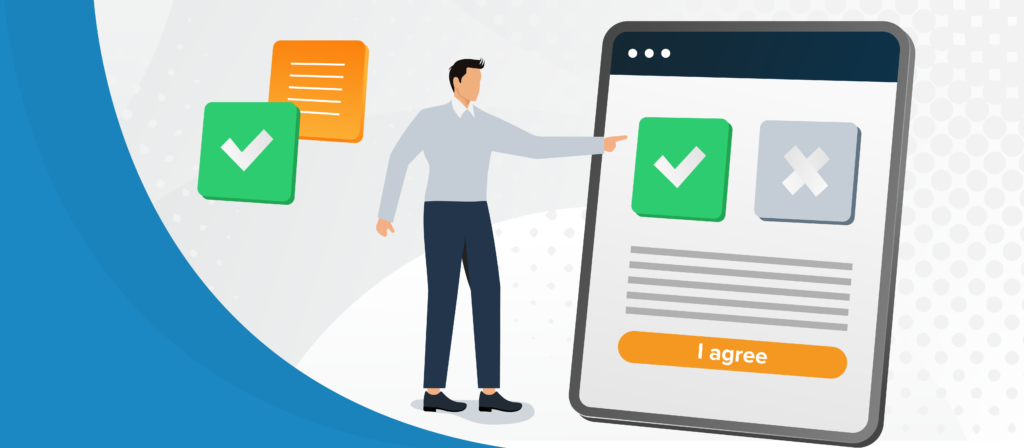Table of Contents
Let’s talk about something we’ve all experienced.
You open your inbox and there it is—yet another email from a company you’ve never subscribed to. Or maybe it’s a random text message trying to sell you something you don’t need. You didn’t ask for this, and honestly, it feels a little… pushy.
Now imagine this instead:
You only hear from brands you signed up for. They send you tips you actually care about. The offers are relevant. The messages feel personal—not like they were blasted to a million strangers.
That’s what consent-based marketing is all about. And it’s the kind of marketing people actually appreciate.
In this blog, I’ll walk you through what consent-based marketing means, why it works so well, and how you can start using it in your own business—without sounding like a robot or a spammer.
What Is Consent-Based Marketing, Really?
Let’s keep it simple.
Consent-based marketing means you only reach out to people who’ve given you clear permission to do so. That’s it. Whether it’s email, SMS, push notifications, or ads—if they didn’t say yes, you don’t send it.
It’s about being respectful, transparent, and honest with your audience. No sneaky checkboxes. No surprises. Just communication that feels welcome—not forced.
And believe it or not, it doesn’t just make people feel better—it also works better.
Why Consent Matters More Than Ever
Marketing has changed a lot. And not just because of tech. People are tired of feeling like their data is being sold to the highest bidder.
Here’s why consent-based marketing is more important now than ever before:
1. People Are More Protective of Their Data
These days, most people know their personal information is valuable. If you want access to it, you’ve got to earn their trust first. Asking for consent is the first step in that relationship.
2. Privacy Laws Are Getting Serious
GDPR, CCPA, India’s new DPDP law—they all require clear consent before collecting or using someone’s data. Consent-based marketing isn’t just a nice idea—it keeps you legally safe.
3. Tech Giants Are Limiting Tracking
Apple blocks email trackers. Google is phasing out cookies. If you’re relying on tracking people without permission, your days are numbered.
Why It Actually Works Better
It might seem like asking for permission would slow things down. But the opposite is true.
When someone chooses to hear from you, they’re more likely to pay attention.
Here’s what makes consent-based marketing so powerful:
People Trust You More
You asked, they said yes. That builds a foundation of trust. It shows you’re not just out for the sale—you’re here to provide value.
Higher Engagement
When someone opts in, they’re interested. That means higher open rates, more clicks, and better responses.
Better Quality Leads
You’re not just building a list—you’re building a community of people who actually care about what you’re offering.
Fewer Complaints
Spam complaints go way down when people know why they’re hearing from you. No surprises = fewer headaches.
How to Do It Right (Without Overthinking It)
You don’t need fancy tech or complicated funnels to start doing consent-based marketing. You just need a little honesty, some thoughtful planning, and the willingness to listen.
Here’s a breakdown:
1. Make Your Opt-Ins Clear
Tell people exactly what they’re signing up for. If it’s a newsletter, say so. If they’ll get deals or updates, mention it. No vague promises. No small print.
Example:
“Want weekly tips, exclusive offers, and behind-the-scenes updates? Join us!”
2. Use Double Opt-In
It’s just a simple confirmation email asking them to click and confirm. It filters out bots and makes sure your list is full of real people who want to be there.
3. Give Options
Not everyone wants the same thing. Let people choose how often they hear from you or what kind of content they’re interested in. That way, they stay engaged and don’t feel overwhelmed.
4. Make Unsubscribing Easy
Yes, really. Give them an easy way out. It shows confidence, and it respects their space. If they’re not feeling it anymore, that’s okay.
5. Keep a Record
Keep track of who opted in, how, and when. Most platforms do this for you, but it’s important to have that info for compliance—and for your own peace of mind.
Where to Use Consent-Based Marketing
This approach isn’t just for email newsletters. You can use it almost everywhere:
Still one of the best-performing channels—if your list is full of people who asked to be there.
Text Messages
Only text people who’ve clearly agreed to it. It’s personal, so treat it with care.
Push Notifications
Whether on an app or browser, ask before sending. And keep the messages useful, not annoying.
Retargeting Ads
With cookies going away, you’ll need first-party data—collected with consent—to keep your targeting sharp and ethical.
Real Brands Doing It Right
Let’s look at a few companies who totally get consent-based marketing:
Duolingo
Their reminders are helpful, never pushy—and you can turn them off any time.
Spotify
You get to choose what emails you receive, right from the start. It feels personal and respectful.
Sephora
They ask what kind of beauty content you want before they ever send an email. It’s customized and relevant.
Avoid These Common Mistakes
Even good brands can slip up. Here are a few things to avoid:
- Pre-checked opt-in boxes (people hate this—and it’s often illegal)
- Not explaining what you’re going to send
- Making it hard to unsubscribe
- Spamming people with daily messages they didn’t expect
- Forgetting to clean or re-engage your list
Final Thoughts: Marketing That Feels Good
Marketing doesn’t have to be aggressive or annoying to work. In fact, the more respectful and human your approach, the better your results will be.
Consent-based marketing isn’t just a legal requirement—it’s a better way to connect. It’s how you build trust, start real conversations, and grow your business with people who genuinely want to be part of what you’re building.
So instead of pushing harder, try asking first. Be clear, be honest, and focus on helping—not just selling.
You might be surprised at how well it works.

